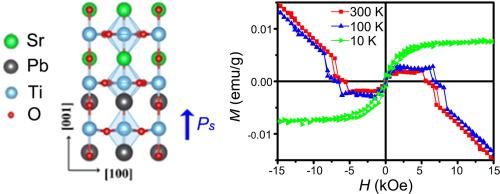Science Bulletin ( IF 18.8 ) Pub Date : 2020-09-19 , DOI: 10.1016/j.scib.2020.09.024 Jialu Chen 1 , Zijun Zhang 2 , Liang Luo 3 , Yunhao Lu 4 , Cheng Song 5 , Di Cheng 3 , Xing Chen 2 , Wei Li 1 , Zhaohui Ren 1 , Jigang Wang 3 , He Tian 2 , Ze Zhang 2 , Gaorong Han 1

|
Oxide heterointerface is a platform to create unprecedented two-dimensional electron gas, superconductivity and ferromagnetism, arising from a polar discontinuity at the interface. In particular, the ability to tune these intriguing effects paves a way to elucidate their fundamental physics and to develop novel electronic/magnetic devices. In this work, we report for the first time that a ferroelectric polarization screening at SrTiO3/PbTiO3 interface is able to drive an electronic construction of Ti atom, giving rise to room-temperature ferromagnetism. Surprisingly, such ferromagnetism can be switched to antiferromagnetism by applying a magnetic field, which is reversible. A coupling of itinerant electrons with local moments at interfacial Ti 3d orbital was proposed to explain the magnetism. The localization of the itinerant electrons under a magnetic field is responsible for the suppression of magnetism. These findings provide new insights into interfacial magnetism and their control by magnetic field relevant interfacial electrons promising for device applications.
中文翻译:

铁电氧化物异质界面的可逆磁性转变
氧化物异质界面是创造前所未有的二维电子气、超导性和铁磁性的平台,由界面处的极性不连续性引起。特别是,调整这些有趣效应的能力为阐明它们的基础物理学和开发新型电子/磁性设备铺平了道路。在这项工作中,我们首次报道了 SrTiO 3 /PbTiO 3界面的铁电极化屏蔽能够驱动 Ti 原子的电子结构,从而产生室温铁磁性。令人惊讶的是,这种铁磁性可以通过施加可逆的磁场转换为反铁磁性。流动电子与界面 Ti 3 d处局部力矩的耦合提出了轨道来解释磁性。流动电子在磁场下的局域化是抑制磁性的原因。这些发现为界面磁性及其通过磁场相关界面电子的控制提供了新的见解,有望用于设备应用。











































 京公网安备 11010802027423号
京公网安备 11010802027423号